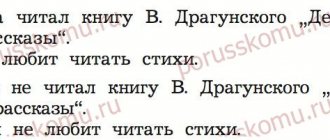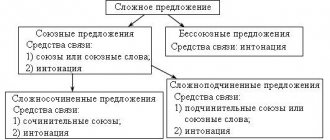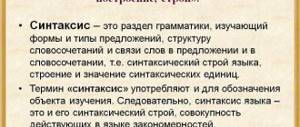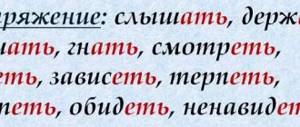Olifirenko Elena Vladimirovna, teacher of Russian language and literature
Russian language lesson in 9th grade
«Complex sentences with subordinate clauses
«.
The purpose of the lesson:
introduce students to subordinate explanatory clauses that are part of the IPP
Lesson objectives:
Educational: find explanatory clauses as part of complex sentences; means of their connection with the main one; correctly place punctuation marks in IPP with explanatory subordinate clauses; draw up diagrams of complex sentences with the specified subordinate clauses; distinguish between attributive and explanatory subordinate clauses with the same means of communication.
Developmental: improving punctuation skills, practical skills in analyzing a complex sentence, and literate writing skills; develop spelling vigilance, memory, attention; develop students’ analytical thinking and the ability to systematize knowledge and draw conclusions independently.
Educational: to cultivate interest in the native language.
Lesson type:
lesson on learning new material
During the classes.
I. Stage of “inclusion” in the lesson
State the topic and purpose of the lesson. For work in this lesson, students receive sheets with a printed base. A sample sheet is in Appendix 1.
2.Checking knowledge of theory
2.1.Updating knowledge. Let's remember:
-What sentences are called complex sentences?
-What main groups are SPPs divided into?
— What do you know about SPPs with attributive clauses?
-What is the difference between pronominal clauses and attributive clauses?
2.2. Individual work using cards
(Students work independently at the board. The contents of the cards are in Appendix 2.).
2.3. Distributive dictation.
—
Distribute complex sentences into 2 groups: 1st group - NGN with proper attributives; Group 2 – SPP with subordinate pronominal attributives. Fill in the missing letters and punctuation marks. Create proposal outlines.
1. There is no greater love than that when people die for each other. 2. Each ship has its own landmark which they are proud of. 3. I had a feeling that I, too..threw some kind of weight. 4. In the river meadows, in the green meadows, a river flows that is dear to me.
Answer: Group 1: 2, 4 Group 2: 1, 3
2.4.Repetition. Preparation for the State Examination. (tasks A5)
— Write down a word with an unstressed vowel alternating at the root. (die - die)
-Write down a word with an unstressed vowel in the root, verified by stress. (dewy)
— Write down words with an unstressed vowel in the root, unchecked by stress. (ship, landmark)
-What spellings did you remember while completing the task?
2.5.Checking individual work using cards.
3.Explanation of new material.
3.1.Analyze the sentences according to the scheme: (the sentences are written on the board. One student works at the board.)
A) Highlight the grammatical basics.
B) Explain punctuation marks.
C) from the main part of the dictionary to the subordinate clause, determine the part of speech of the words being explained.
D) Draw a conclusion by filling out the table.
1) All night we lay by the fire, dozed and listened to the raging sea.
2) Grandmother was not sure whether her grandson would come for the summer holidays.
3) I told the boys that I was lost and sat down with them.
4) It seemed that the floors were being washed in the house and all the furniture was temporarily moved here.
5) The important thing was that no one noticed him.
6) I found out where the letter was hidden.
It is necessary to draw students' attention to the words in the main part that need clarification (they can be verbs, words of the state category, adjectives, nouns); they denote the processes of speech, thought, perception, as well as feeling and state. In the examples given, these words were listened to, I wasn’t sure, he said, it seemed important, it was known. They only indicate the content that is revealed in the subordinate clause.
In the process of work, the difference between unions and allied words becomes clear again. So, in the sixth example, the subordinate clause is joined by the conjunctive word where, which performs the function of an adverbial adverbial place in the sentence. In the second example, the interrogative particle is the conjunction
Conclusion:
explanatory subordinate clauses answer case questions and explain the words of the main part of the IPP. The words to be explained are words of different parts of speech, denoting thoughts, feelings, perceptions of a person, his speech: verbs, adjectives, adverbs and words of the state category, nouns.
3.2. Filling out the table
Type of subordinate part______________________________________________________________________________
What does the subordinate clause refer to?
4. Training exercises.
Write down the sentences, indicate the IPP with explanatory clauses. Highlight the grammatical basics, draw up sentence diagrams, indicate the means of connecting the subordinate clause with the main clause. Put the conjunctions in an oval, and underline the connecting words as part of the sentence. Explain punctuation marks. (one student writes down and comments on the proposals at the board). The teacher dictates the sentences.
1. The gorge along which we walked was long and winding. 2. Alexey felt that he was weakening from tension and pain. 3. The commander of the first company asked where to feed the soldiers. 4. Do not get close to people whose conscience is too flexible.5. The father carefully looked to see if the boys were sleeping. 6. The sky and the sea are arguing with each other, who is better, who is quieter.
5. Practicing the ability to distinguish between types of subordinate clauses
Exercise:
Indicate the main and subordinate clauses as part of the IPP. Fill in the missing punctuation marks. Determine the type of subordinate clauses.
I don't know when this will be. – We get to know friends and loved ones at the hour when trouble threatens. – People stop thinking when they stop reading.
-Draw a conclusion about how to determine the type of subordinate clauses if the same conjunction or allied word acts as a means of communication.
Conclusion:
the same conjunctions and allied words can attach different types of subordinate clauses. It's important to ask the right question.
6. Consolidation of the studied material
6.1.Individual work at the board using cards.
(The contents of the cards are presented in Appendix 3)
6.2. Independent work followed by mutual testing (work in pairs)
Exercise:
Place punctuation marks. Determine the type of subordinate clauses. Make diagrams. (Sentence diagrams are pre-drawn on the board)
1. On a cliff that towered in the bright sky, a lonely bench stood black.
2. It seemed that the city was tired of winter.
3. (Not) (in) far from the house where the writer lived, a huge poplar grew.
4. I know from old hunts how beautiful the last days of autumn
.
5. The investigator guessed where the criminal might be hiding.
6. It is (not) rare that such interesting conversations take place in the carriage that you would not see among friends.
Write down the highlighted phrase. Specify the type of communication. Replace it with a synonymous phrase with the connection CONCORDING.
6.3.Checking individual work using cards.
6.4. Role-playing game “Smart Corrector” (The exercise is performed orally.)
Exercise.
Try to explain what is grammatically incorrect in the sentences included in the assignment.
1. The commander said that the assignment given to me was a simple test. (missing conjunction what)
2. He thought that we misunderstood him.
3.During the conversation, the children were asked whether the donated books were interesting to them. (In indirect interrogative sentences, you cannot simultaneously use a subordinating conjunction and the particle whether as a conjunction).
4. My brother asked me why I took my younger sister with me. (In indirect interrogative sentences, you cannot simultaneously use the conjunction that and another conjunction word).
7. Summing up the lesson.
Work with the table compiled in class.
-What did you learn about NGN with explanatory clauses?
8.Grading.
9.Homework. Exercise No. 134, paragraph 15, working with the table that the students compiled in class.
Annex 1
Sheet with printed base:
Subject: ________________________________________________________________________
During the classes.
1. Stage of “inclusion” in the lesson. Communicating the topic and purpose of the lesson
2.Checking knowledge of theory
2.1.Updating knowledge. Let's remember:
-What sentences are called complex sentences?
-What main groups are SPPs divided into?
— What do you know about SPPs with attributive clauses?
-What is the difference between pronominal clauses and attributive clauses?
2.3. Distributive dictation.
Distribute complex sentences into 2 groups: 1st group - NGN with proper attributives; Group 2 – SPP with subordinate pronominal attributives. Fill in the missing letters and punctuation marks. Create proposal outlines.
1. There is no greater love than that when people die for each other. 2. Each ship has its own landmark which they are proud of. 3. I had a feeling that I, too..threw some kind of weight. 4. In the river meadows, in the green meadows, a river flows that is dear to me.
NGN with proper definitions
2.4.Repetition. Preparation for the State Examination. (tasks A5)
-Write down a word with an unstressed vowel alternating at the root.
_______________________________
-Write down a word with an unstressed vowel in the root, verified by stress.
____________________________________________________
-Write down words with an unstressed vowel in the root that is not verified by stress.
______________________________________________________________
-What spellings did you remember while completing the task?
3.Explanation of new material.
3.1.Analyze the sentences according to the scheme:
A) Highlight the grammatical basics.
B) Explain punctuation marks.
C) from the main part of the dictionary to the subordinate clause, determine the part of speech of the words being explained.
D) Draw a conclusion by filling out the table.
1) All night we lay by the fire dozing and listened to the raging sea.
2) Grandmother was not sure whether her grandson would come for the summer holidays.
3) I told the boys that I was lost and sat down with them.
4) It seemed that the floors were being washed in the house and all the furniture was temporarily moved here.
5) The important thing was that no one noticed him.
6) I found out where the letter was hidden.
Conclusion:___________________________________________________________________________________________________________________________________________________________________________________________________________________________________________________________________________________________________________________________________________________________________________________
3.2. Filling out the table
Type of subordinate part______________________________________________________________________________
What does the subordinate clause refer to?
4. Training exercises.
Write down the sentences, indicate the IPP with explanatory clauses. Highlight the grammatical basics, draw up sentence diagrams, indicate the means of connecting the subordinate clause with the main one. Put the conjunctions in an oval, and underline the connecting words as part of the sentence. Explain punctuation marks.
_________________________________________________________________________________________________
_________________________________________________________________________________________________
_____________________________________________________________________________________________________________________________________________________________________________________________________________________________________________________________________________________________________________________________________________________________________________________________________________________________________________________________________________________________________________________________________________________________________________________________________
5. Practicing the ability to distinguish between types of subordinate clauses.
Exercise:
Indicate the main and subordinate clauses as part of the IPP. Place the missing punctuation marks. Determine the type of subordinate clauses.
1.I don’t know when this will be. ______________________________________________________________________________
2. We get to know friends and loved ones at the hour when trouble threatens. _________________________________________________
3.People stop thinking when they stop reading._________________________________________________
-Draw a conclusion about how to determine the type of subordinate clauses if the same conjunction or allied word acts as a means of communication.
Conclusion:_____________________________________________________________________________________________________________________
________________________________________________________________________________________________________________________________
6. Consolidation of the studied material.
6.1.Individual work at the board using cards.
6.2. Independent work followed by mutual testing (work in pairs)
Exercise:
Place punctuation marks. Determine the type of subordinate clauses. Make diagrams.
- On the cliff that towered in the bright sky, a lonely bench was blackened.
____________________________________________________________________________________________________________
- It seemed that the city was tired of winter.
_______________________________________________________________________________________________________________
- (Not) (in) far from the house where the writer lived there grew a huge poplar tree.
_______________________________________________________________________________________________________________-
- From old hunts I know how wonderful the last ones can be days of autumn
.
_________________________________________________________________________________________________________________
- The investigator guessed where the criminal might be hiding.
_______________________________________________________________________________________________________________
- (It’s not) rare that such interesting conversations take place in the carriage that you would never see among friends.
______________________________________________________________________________________________________________________
Write down the highlighted phrase. Specify the type of communication. Replace it with a synonymous phrase with the connection CONCORDING
__________________________________________________________________________________________________________________________________
6.4.Role game “Smart corrector” (The exercise is performed orally.)
Exercise.
Try to explain what is incorrect in the sentences included in the task from a grammatical point of view.
1. The commander said that the assignment given to me was a simple test.
2. He thought that we misunderstood him.
3.During the conversation, the children were asked whether the donated books were interesting to them.
4. My brother asked me why I took my younger sister with me.
7. Summing up the lesson. Work with the table compiled in class.
-What did you learn about NGN with explanatory clauses?
9.Homework. Exercise No. 134, paragraph 15, working with the table that the students compiled in class.
Appendix 2.
CARD No. 1
Write down the phrases, insert the missing letters. Indicate the spelling graphically.
Indicate the type of subordinating connection in the phrase.
brightened up with a smile, grew up imperceptibly, a light touch, a waterproof raincoat, get in line, milk with heat, a gentle mouth, freeze with admiration.
CARD No. 2
Fill in the missing letters at the root of the word. Explain this spelling graphically .
What type of subordinating connection is used to connect all the phrases?
To steal for treason - to steal cities, to wash a dog - to wash clothes, to write boots - to write a pencil, to grow old - to sit in a chair, take on a coat - take on the hostiles, develop..with the wind - develop..abilities, infuse sadness - infuse...curls, hide..with the heart - hide..sing with a chair.
Appendix 3
CARD No. 1.
Write down the sentences using punctuation marks.
Create proposal outlines. Specify the type of subordinate clauses.
- (N...) who (not) could say that (would) ever see him at any (or) evening.
- There is talk in the village that his daughter-in-law kicked him out of her own house.
- He (didn’t) know whether they would come again.
From sentence 2, write down a phrase with the connection CONCORDING.
__________________________________________________________________________________________________________________
CARD No. 2.
Write down the sentences using punctuation marks.
Create proposal outlines. Specify the type of subordinate clauses.
- A sparrow(?) was scurrying around in the s...rubum bushes, which were getting in your face with their p...ing flowers.
- What is written with a pen (not) cut out...w(?) with an axe.
- I asked our counselor who catches sables here.
From the main part of sentence 1, write down a phrase with the connection CONCORDING. Replace it with a synonym for the CONTROL relationship.
__________________________________________________________________________________________________________________
CARD No. 3.
Write down the sentences using punctuation marks.
Create proposal outlines. Specify the type of subordinate clauses.
- He who (does not) love people should (not) engage in charity.
- It seemed to me that he was terribly pale.
- He came with the news that the horses were ready.
Perform morphemic analysis of the selected word
| What question does it answer? | Means of communication with the main | |
| unions | Conjunctive words | |
| NGN with pronominal attributives | ||
| What question does it answer? | Means of communication with the main | |
| unions | Conjunctive words | |
Technological map of a Russian language lesson in 9th grade on the topic “SPP with subordinate clauses”
1.Working with the textbook.Write down the sentences, indicate the IPP with explanatory clauses. Highlight the grammatical basics, draw up sentence diagrams, indicate the means of connecting the subordinate clause with the main one. Put the conjunctions in an oval, and underline the connecting words as part of the sentence. Explain punctuation marks. (one student writes down and comments on the proposals at the board). 1. The gorge along which we walked was long and winding. 2. Alexey felt that he was weakening from tension and pain. 3. The commander of the first company asked where to feed the soldiers. 4. Do not get close to people whose conscience is too flexible.5. The father carefully looked to see if the boys were sleeping. 6. The sky and the sea are arguing with each other, who is better, who is quieter.
2. Role-playing game “Smart Corrector” (The exercise is performed orally.)
Exercise.
Try to explain what is grammatically incorrect in the sentences included in the assignment.
1. The commander said that the assignment given to me was a simple test. (missing conjunction what)
2. He thought that we misunderstood him.
3.During the conversation, the children were asked whether the donated books were interesting to them. (In indirect interrogative sentences, you cannot simultaneously use a subordinating conjunction and the particle whether as a conjunction).
4. My brother asked me why I took my younger sister with me. (In indirect interrogative sentences, you cannot simultaneously use the conjunction that and another conjunction word).
3.Comprehensive text analysis
Listening to Daniyar, I wanted to fall to the ground and hug her tightly, like a son, just because a person can love her so much. For the first time, I felt something new awaken within me. Something that I still couldn’t name woke up. It was a need to express oneself, to convey to others one’s vision, one’s thoughts and feelings, to tell people about the beauty of our land in the same inspired way as Daniyar did. I was frozen with unaccountable fear and joy in front of something unknown. But even then I still didn’t understand that I needed to pick up a brush. I loved drawing since childhood. I copied pictures from textbooks. The guys said that I did it “exactly.” Teachers at school also praised me when I brought drawings to our wall newspaper. And then the war began... I completely forgot about paints and brushes and didn’t think that I would ever remember about them. But Daniyar’s songs stirred my soul. I walked as if in a dream and looked at the world with amazed eyes, as if I was seeing everything for the first time.
Ch. Aitmatov
Determine the style and type of speech.
Replace the word “to alarm” with a synonym.
Find sentences with explanatory clauses in 1 paragraph, read them, prove them by asking a question.
Write down 1 sentence, graphically explain the punctuation marks, make a diagram.
Does the second paragraph contain clauses with explanatory clauses?
Find in the text a word with a root with alternation.
Find words with unpronounceable consonants at the root of the word.








